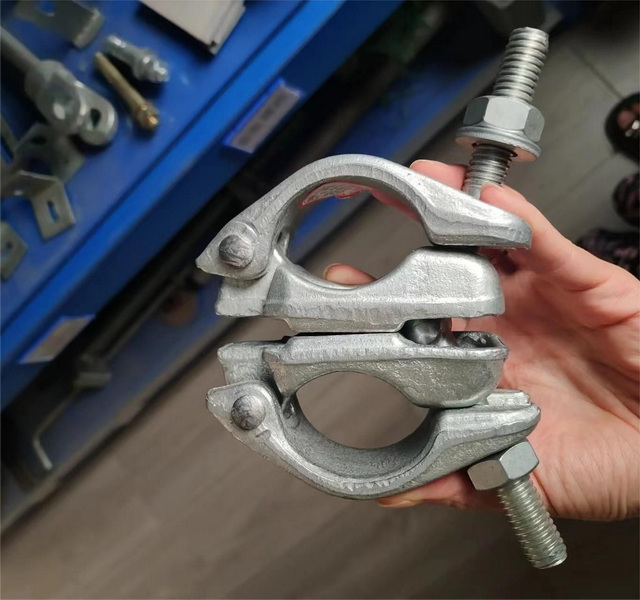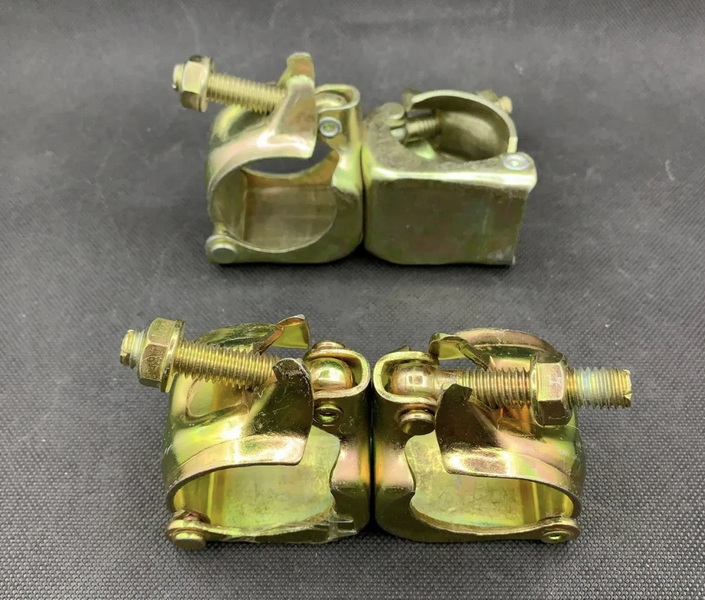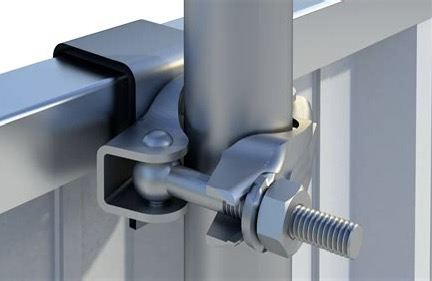Content Menu
● Understanding Scaffolding Couplers and Their Importance
● Types of Scaffolding Couplers
● Load Capacity of Standard Scaffolding Couplers
>> Typical Load Capacities
>> Load Capacity Table for Girder Couplers
● Factors Affecting Scaffolding Coupler Load Capacity
>> Material and Manufacturing Quality
>> Coupler Class and Standards
>> Tightening Torque
>> Load Type and Direction
>> Environmental Conditions
● Practical Load Capacity Examples
>> Calculating Load Capacity of Scaffold Tubes
>> Load Capacity in Real-World Scenarios
● Safety Considerations and Best Practices
>> Regular Inspection and Maintenance
>> Proper Installation Techniques
>> Compliance with Standards
● Conclusion
● FAQ
>> 1. What is the typical load capacity of a double scaffolding coupler?
>> 2. How does a swivel coupler's load capacity compare to a double coupler?
>> 3. What factors affect the load capacity of scaffolding couplers?
>> 4. Can girder couplers be used to attach scaffolding to beams?
>> 5. How important is tightening torque for scaffolding couplers?
● Citations:
Scaffolding couplers are critical components in the construction industry, serving as the connectors that hold scaffold tubes together to form a safe and stable working platform. Understanding the scaffolding coupler load capacity is essential for ensuring safety, structural integrity, and compliance with industry standards. This article explores the types of scaffolding couplers, their load capacities, factors affecting their strength, and practical considerations for their use.

Understanding Scaffolding Couplers and Their Importance
Scaffolding couplers, also known as clamps or fittings, connect scaffold tubes to create a rigid structure. Their performance directly impacts the overall load-bearing capacity of scaffolding systems, which must safely support workers, materials, and equipment.
Types of Scaffolding Couplers
The main types of scaffolding couplers include:
- Double Couplers (Right Angle Couplers): Connect two scaffold tubes at a 90-degree angle.
- Swivel Couplers: Allow tubes to connect at any angle.
- Sleeve (End-to-End) Couplers: Join two tubes end-to-end to extend length.
- Girder Couplers: Attach scaffold tubes to beams or structural sections.
- Putlog Couplers: Connect transoms or putlogs to ledgers.
Each type has specific load capacities and applications, influencing the overall scaffold design and safety.
Load Capacity of Standard Scaffolding Couplers
Typical Load Capacities
- Double Couplers: These are among the most commonly used couplers and have a typical working load limit of approximately 6.25 kN (about 637 kgf) against slip when tightened to the recommended torque of 54 Nm. High-quality double couplers made from drop-forged steel and hot-dip galvanized for corrosion resistance are designed to resist both tension and compression loads.
- Swivel Couplers: Swivel couplers can bear loads exceeding 14 kN (Class A) and up to 20 kN (Class B), depending on the standard they comply with (EN 74). They offer flexibility by allowing connections at various angles without compromising strength.
- Girder Couplers: These couplers are designed for connecting scaffold tubes to structural beams and can handle vertical loads up to 30 kN per pair when uniformly loaded, with lower capacities for eccentric or horizontal loads.
Load Capacity Table for Girder Couplers
Position | Load Type |
Y-axis (vertical), Uniformly loaded | 30 kN per pair |
Y-axis (vertical), Eccentrically loaded | 15 kN on leading coupler |
Z-axis (horizontal), Uniformly loaded | 6.5 kN per pair |
X-axis (horizontal), Uniformly loaded | 10 kN per pair |

Factors Affecting Scaffolding Coupler Load Capacity
Material and Manufacturing Quality
Couplers are typically made from drop-forged or pressed steel, which provides high strength and durability. The finish, such as hot-dip galvanizing, protects against corrosion, extending the coupler's lifespan and maintaining load capacity.
Coupler Class and Standards
Couplers are classified into Class A and Class B, with Class B generally offering higher load capacities. For example, Class A right-angle couplers have a slipping resistance around 6.1 kN, while Class B couplers can resist up to 9.1 kN.
Tightening Torque
Proper tightening of couplers is crucial. The standard tightening torque is about 54 Nm, which ensures the coupler achieves its rated load capacity without slipping.
Load Type and Direction
The load capacity varies depending on whether the load is tensile, compressive, shear, or bending, and the direction of the load relative to the coupler. For example, girder couplers have different capacities for vertical versus horizontal loads.
Environmental Conditions
Environmental factors such as temperature, humidity, and exposure to chemicals can affect the performance of scaffolding couplers. Corrosion caused by moisture or chemical exposure can weaken couplers over time, reducing their load capacity. Therefore, regular inspection and maintenance are essential to ensure couplers remain safe and reliable.
Practical Load Capacity Examples
Calculating Load Capacity of Scaffold Tubes
The load capacity of the scaffold tubes connected by couplers also influences the overall system capacity. For a standard scaffold tube with a 48.3 mm outer diameter and 3.2 mm thickness, made of steel with a yield strength of 250 MPa, the axial load capacity can be calculated as:
Nt=At×fy×ϕ=453.4 mm2×250 MPa×0.9=102.01 kN
This means the tube itself can support loads significantly higher than the coupler's slip resistance, making the coupler the critical component for load limits.
Load Capacity in Real-World Scenarios
In real construction environments, the scaffolding coupler load capacity must be considered alongside the total scaffold design, including the number of couplers used, the spacing of scaffold tubes, and the expected load distribution. For example, a scaffold supporting heavy materials will require couplers with higher load capacities and more frequent inspection to prevent failure.
Safety Considerations and Best Practices
Regular Inspection and Maintenance
To maintain the scaffolding coupler load capacity, regular inspections should be conducted to check for signs of wear, corrosion, or damage. Damaged couplers should be replaced immediately to prevent structural failure.
Proper Installation Techniques
Ensuring couplers are installed correctly with the recommended tightening torque is vital. Over-tightening can damage the coupler or scaffold tube, while under-tightening can lead to slipping and reduced load capacity.
Compliance with Standards
Adhering to international and local standards such as EN 74, OSHA, and ANSI ensures that scaffolding systems meet minimum safety requirements. These standards specify minimum load capacities, testing procedures, and quality requirements for couplers.
Conclusion
The scaffolding coupler load capacity is a vital parameter for ensuring the safety and effectiveness of scaffold structures. Standard double couplers typically have a working load limit around 6.25 kN, while swivel and girder couplers can handle higher loads depending on their class and application. Proper selection, installation, and maintenance of couplers, along with adherence to safety standards, are essential for preventing accidents and ensuring structural integrity on construction sites.
By understanding the load capacities and factors that affect them, construction professionals can design safer scaffolding systems that protect workers and materials alike. Regular inspection and compliance with industry standards further enhance safety and reliability.

FAQ
1. What is the typical load capacity of a double scaffolding coupler?
Double couplers usually have a working load limit of about 6.25 kN (approximately 637 kgf) when tightened correctly.
2. How does a swivel coupler's load capacity compare to a double coupler?
Swivel couplers generally have higher load capacities, ranging from 14 kN (Class A) to 20 kN (Class B), and allow connections at various angles.
3. What factors affect the load capacity of scaffolding couplers?
Material quality, coupler class (A or B), tightening torque, load direction/type, and environmental conditions all influence the load capacity.
4. Can girder couplers be used to attach scaffolding to beams?
Yes, girder couplers are designed for this purpose and can support vertical loads up to 30 kN per pair, depending on load conditions.
5. How important is tightening torque for scaffolding couplers?
Tightening torque, typically around 54 Nm, is critical to achieve the rated load capacity and prevent slipping.
Citations:
[1] https://rlsdhamal.com/scaffolding-couplers-working-load-capacity/
[2] https://scaffoldtype.com/scaffolding-coupler/
[3] https://skyciv.com/quick-calculators/scaffolding-calculator/
[4] https://www.youtube.com/watch?v=xikbzjq-f3I
[5] https://www.linkedin.com/pulse/access-scaffolding-couplers-capacity-abdelrahman-elkholly
[6] https://scaffoldtype.com/scaffold-load-ratings/
[7] https://www.altradgeneration.com/assets/files/guides_and_documents/scaffolding/scaffold-coupler-manual.pdf
[8] https://www.wm-scaffold.com/scaffolding-coupler.html
[9] https://www.youtube.com/watch?v=MQngkF50Sio
[10] https://www.gd-scaffold.com/news/understanding-the-load-capacity-of-scaffolding-clamps.html
[11] https://scaffoldtype.com/tube-and-coupler-scaffolding/
[12] https://www.scaffolding-couplers.com/quality-9976217-scaffolding-double-coupler-load-capacity
[13] https://shelterrc.com/scaffolding-couplers-types-a-comprehensive-guide/
[14] https://www.acrow.com.au/wp-content/uploads/2020/11/couplers-product-guide.pdf
[15] https://www.linkedin.com/pulse/maximizing-efficiency-ultimate-guide-using-girder-load-elkholly
[16] https://grsscaffolding.com/blog/scaffolding-couplers-types/
[17] https://www.tp-scaffold.com/What-s-the-load-capacity-of-scaffolding-coupler-id8237214.html
[18] http://www.osha.gov/laws-regs/regulations/standardnumber/1926/1926SubpartLAppA
[19] https://www.scaffolding-couplers.com/sale-9976217-scaffolding-double-coupler-load-capacity.html
[20] https://www.osha.gov/sites/default/files/publications/osha3150.pdf
[21] https://www.minjiesteel.com/forged-scaffolding-clamp-swivel-coupler.html
[22] https://nordscaffolding.en.made-in-china.com/product/awUftHOdgITY/China-Scaffolding-Sleeve-Coupler-Load-Capacity-Coupler-48-3mm-Scaffolding-Pipe-Sleeve-Clamp.html
[23] https://fsjianyi.en.made-in-china.com/product/BjpJCzUAYPku/China-Free-Sample-Worldwide-Simple-Types-of-Scaffolding-Couplers-Scaffold-Double-Coupler.html
[24] https://www.altradgeneration.com/assets/files/guides_and_documents/scaffolding/scaffold-coupler-manual.pdf
[25] https://www.osha.gov/sites/default/files/publications/OSHA_FS-3759.pdf
[26] https://www.acrow.com.au/wp-content/uploads/2020/11/couplers-product-guide.pdf
[27] https://apacsafety.com/the-ultimate-guide-of-scaffolding-couplers/
[28] https://policies.unc.edu/TDClient/2833/Portal/KB/ArticleDet?ID=132007
[29] https://www.adtoscaffold.com/new/how_to_determine_load_bearing_capacity_of_scaffolding_coupler.html
[30] https://www.youtube.com/watch?v=dG0XGpLPB3M
[31] https://www.youtube.com/watch?v=ehKj8okfWI8






















